Comprehensive Patient Assessment Report: Anaphylaxis Post-Vaccination
VerifiedAdded on 2023/06/10
|11
|3943
|201
Report
AI Summary
This report presents a comprehensive patient assessment of a patient who experienced an anaphylactic reaction after receiving a COVID-19 vaccination in an emergency department setting. The assessment meticulously follows the nursing process, including the assessment phase, diagnosis phase, planning phase, implementation phase, and evaluation phase, to provide a holistic approach to patient care. The report analyzes the patient's health history, objective data, and potential causes of the anaphylactic reaction, such as the vaccine and other allergic medications. It emphasizes the importance of a systematic approach to manage the patient's needs, including the administration of appropriate medications, such as antihistaminergic drugs. The report also outlines the implementation of nursing interventions and the evaluation of outcomes to ensure effective patient care. Findings include the necessity for prompt oxygen therapy and a thorough assessment of the patient's health history. Recommendations are provided for the effective delivery of healthcare services and treatment, including the implementation of nursing interventions to reduce the risk of negative health impacts and improve patient health outcomes. The report highlights the critical role of nurses in managing anaphylactic reactions and providing comprehensive patient care in emergency situations.
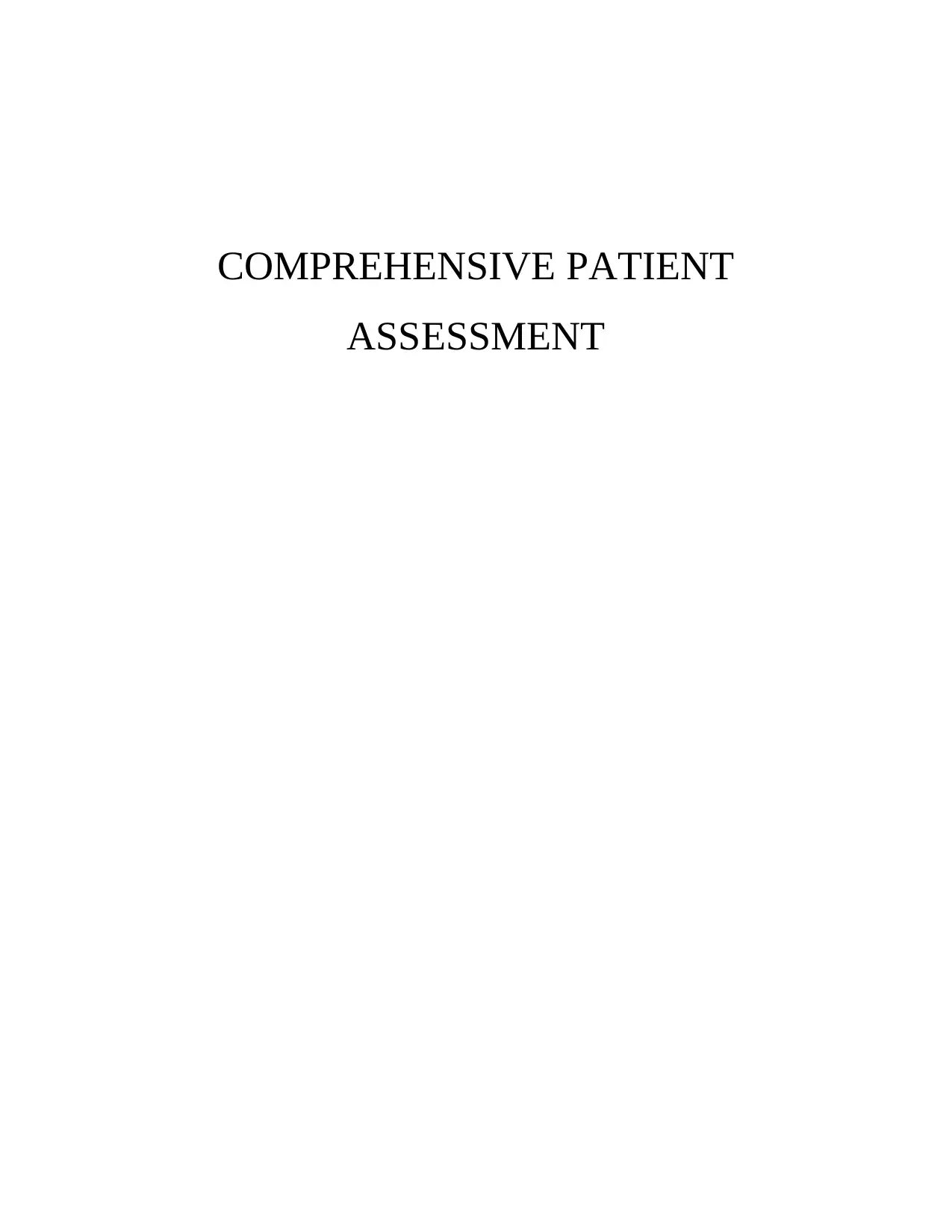
COMPREHENSIVE PATIENT
ASSESSMENT
ASSESSMENT
Paraphrase This Document
Need a fresh take? Get an instant paraphrase of this document with our AI Paraphraser
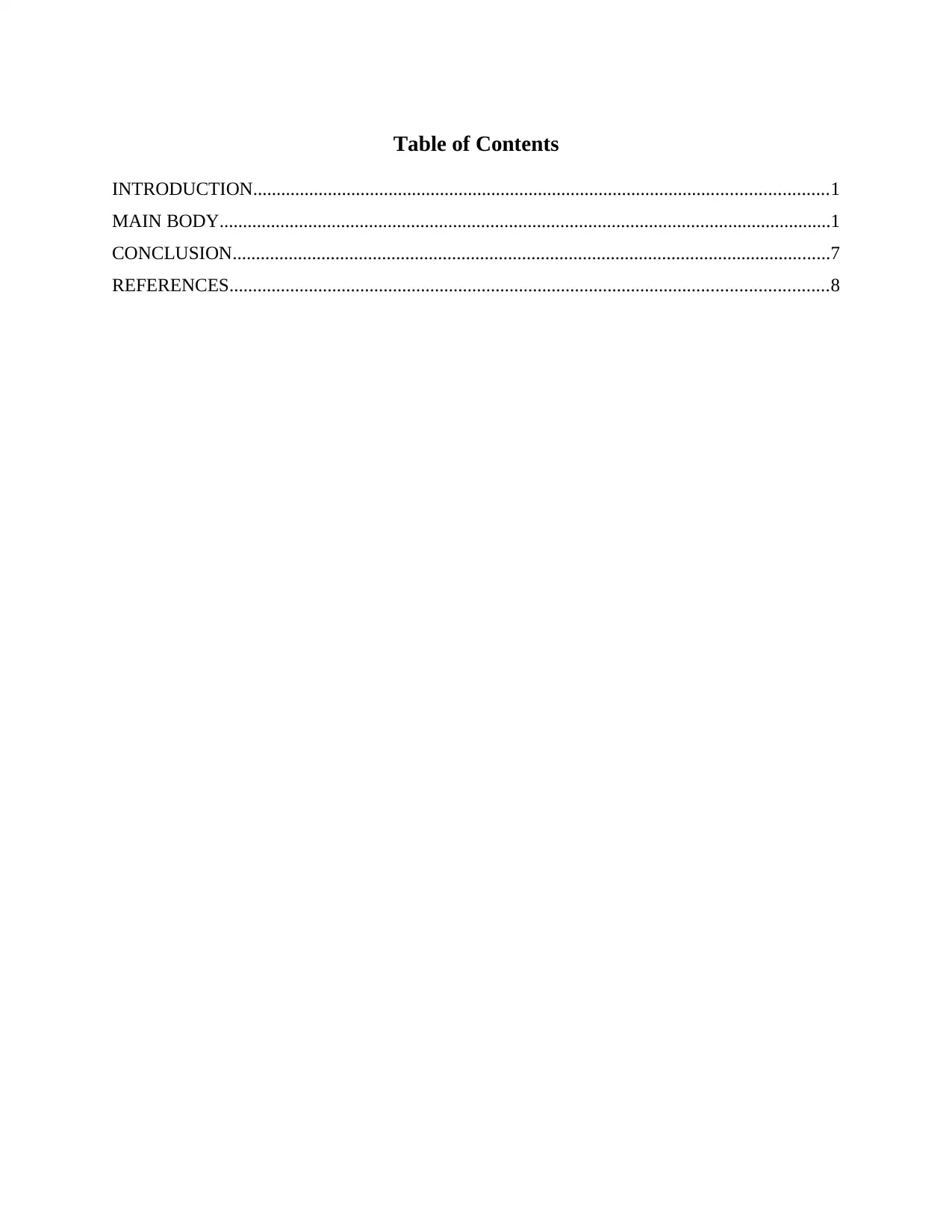
Table of Contents
INTRODUCTION...........................................................................................................................1
MAIN BODY...................................................................................................................................1
CONCLUSION................................................................................................................................7
REFERENCES................................................................................................................................8
INTRODUCTION...........................................................................................................................1
MAIN BODY...................................................................................................................................1
CONCLUSION................................................................................................................................7
REFERENCES................................................................................................................................8
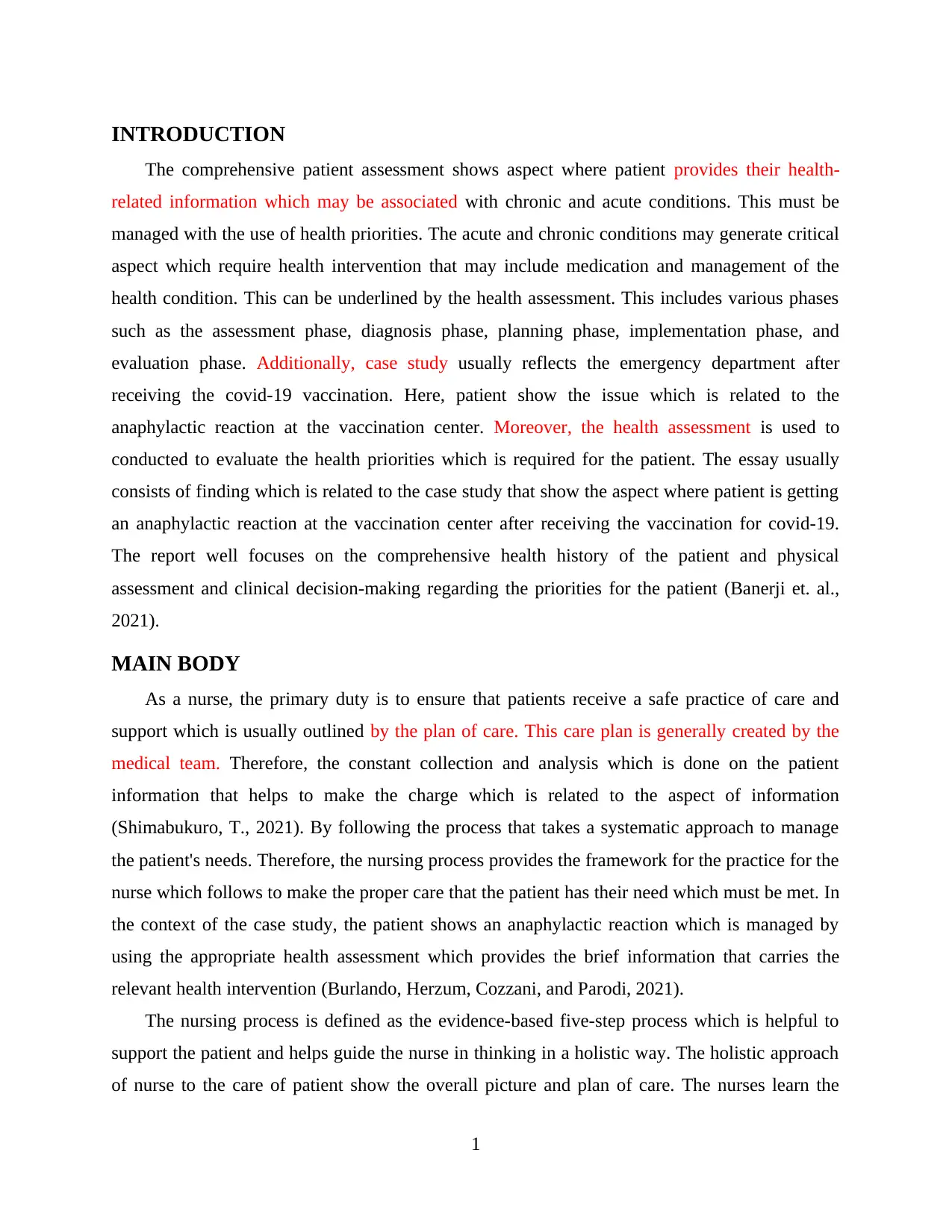
INTRODUCTION
The comprehensive patient assessment shows aspect where patient provides their health-
related information which may be associated with chronic and acute conditions. This must be
managed with the use of health priorities. The acute and chronic conditions may generate critical
aspect which require health intervention that may include medication and management of the
health condition. This can be underlined by the health assessment. This includes various phases
such as the assessment phase, diagnosis phase, planning phase, implementation phase, and
evaluation phase. Additionally, case study usually reflects the emergency department after
receiving the covid-19 vaccination. Here, patient show the issue which is related to the
anaphylactic reaction at the vaccination center. Moreover, the health assessment is used to
conducted to evaluate the health priorities which is required for the patient. The essay usually
consists of finding which is related to the case study that show the aspect where patient is getting
an anaphylactic reaction at the vaccination center after receiving the vaccination for covid-19.
The report well focuses on the comprehensive health history of the patient and physical
assessment and clinical decision-making regarding the priorities for the patient (Banerji et. al.,
2021).
MAIN BODY
As a nurse, the primary duty is to ensure that patients receive a safe practice of care and
support which is usually outlined by the plan of care. This care plan is generally created by the
medical team. Therefore, the constant collection and analysis which is done on the patient
information that helps to make the charge which is related to the aspect of information
(Shimabukuro, T., 2021). By following the process that takes a systematic approach to manage
the patient's needs. Therefore, the nursing process provides the framework for the practice for the
nurse which follows to make the proper care that the patient has their need which must be met. In
the context of the case study, the patient shows an anaphylactic reaction which is managed by
using the appropriate health assessment which provides the brief information that carries the
relevant health intervention (Burlando, Herzum, Cozzani, and Parodi, 2021).
The nursing process is defined as the evidence-based five-step process which is helpful to
support the patient and helps guide the nurse in thinking in a holistic way. The holistic approach
of nurse to the care of patient show the overall picture and plan of care. The nurses learn the
1
The comprehensive patient assessment shows aspect where patient provides their health-
related information which may be associated with chronic and acute conditions. This must be
managed with the use of health priorities. The acute and chronic conditions may generate critical
aspect which require health intervention that may include medication and management of the
health condition. This can be underlined by the health assessment. This includes various phases
such as the assessment phase, diagnosis phase, planning phase, implementation phase, and
evaluation phase. Additionally, case study usually reflects the emergency department after
receiving the covid-19 vaccination. Here, patient show the issue which is related to the
anaphylactic reaction at the vaccination center. Moreover, the health assessment is used to
conducted to evaluate the health priorities which is required for the patient. The essay usually
consists of finding which is related to the case study that show the aspect where patient is getting
an anaphylactic reaction at the vaccination center after receiving the vaccination for covid-19.
The report well focuses on the comprehensive health history of the patient and physical
assessment and clinical decision-making regarding the priorities for the patient (Banerji et. al.,
2021).
MAIN BODY
As a nurse, the primary duty is to ensure that patients receive a safe practice of care and
support which is usually outlined by the plan of care. This care plan is generally created by the
medical team. Therefore, the constant collection and analysis which is done on the patient
information that helps to make the charge which is related to the aspect of information
(Shimabukuro, T., 2021). By following the process that takes a systematic approach to manage
the patient's needs. Therefore, the nursing process provides the framework for the practice for the
nurse which follows to make the proper care that the patient has their need which must be met. In
the context of the case study, the patient shows an anaphylactic reaction which is managed by
using the appropriate health assessment which provides the brief information that carries the
relevant health intervention (Burlando, Herzum, Cozzani, and Parodi, 2021).
The nursing process is defined as the evidence-based five-step process which is helpful to
support the patient and helps guide the nurse in thinking in a holistic way. The holistic approach
of nurse to the care of patient show the overall picture and plan of care. The nurses learn the
1
⊘ This is a preview!⊘
Do you want full access?
Subscribe today to unlock all pages.

Trusted by 1+ million students worldwide
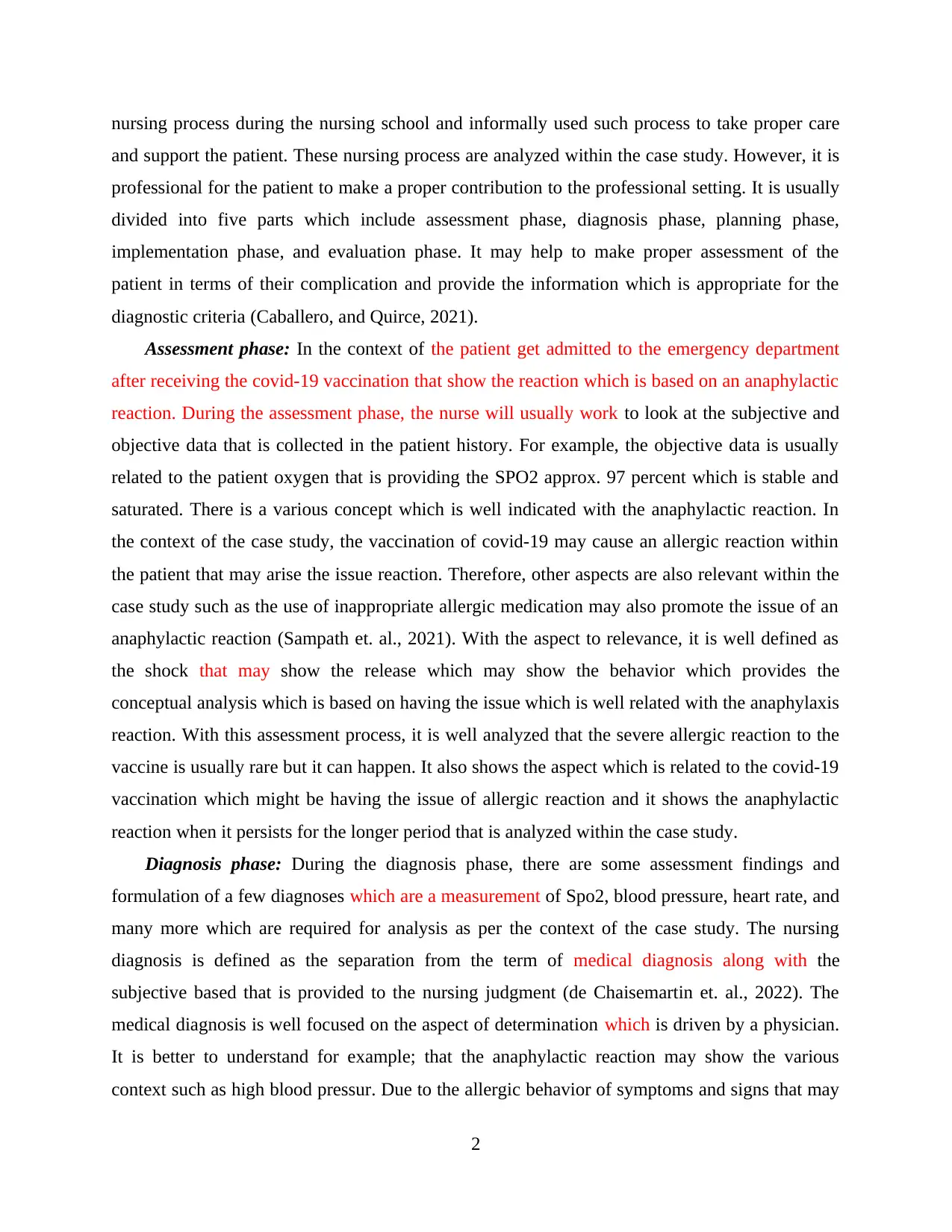
nursing process during the nursing school and informally used such process to take proper care
and support the patient. These nursing process are analyzed within the case study. However, it is
professional for the patient to make a proper contribution to the professional setting. It is usually
divided into five parts which include assessment phase, diagnosis phase, planning phase,
implementation phase, and evaluation phase. It may help to make proper assessment of the
patient in terms of their complication and provide the information which is appropriate for the
diagnostic criteria (Caballero, and Quirce, 2021).
Assessment phase: In the context of the patient get admitted to the emergency department
after receiving the covid-19 vaccination that show the reaction which is based on an anaphylactic
reaction. During the assessment phase, the nurse will usually work to look at the subjective and
objective data that is collected in the patient history. For example, the objective data is usually
related to the patient oxygen that is providing the SPO2 approx. 97 percent which is stable and
saturated. There is a various concept which is well indicated with the anaphylactic reaction. In
the context of the case study, the vaccination of covid-19 may cause an allergic reaction within
the patient that may arise the issue reaction. Therefore, other aspects are also relevant within the
case study such as the use of inappropriate allergic medication may also promote the issue of an
anaphylactic reaction (Sampath et. al., 2021). With the aspect to relevance, it is well defined as
the shock that may show the release which may show the behavior which provides the
conceptual analysis which is based on having the issue which is well related with the anaphylaxis
reaction. With this assessment process, it is well analyzed that the severe allergic reaction to the
vaccine is usually rare but it can happen. It also shows the aspect which is related to the covid-19
vaccination which might be having the issue of allergic reaction and it shows the anaphylactic
reaction when it persists for the longer period that is analyzed within the case study.
Diagnosis phase: During the diagnosis phase, there are some assessment findings and
formulation of a few diagnoses which are a measurement of Spo2, blood pressure, heart rate, and
many more which are required for analysis as per the context of the case study. The nursing
diagnosis is defined as the separation from the term of medical diagnosis along with the
subjective based that is provided to the nursing judgment (de Chaisemartin et. al., 2022). The
medical diagnosis is well focused on the aspect of determination which is driven by a physician.
It is better to understand for example; that the anaphylactic reaction may show the various
context such as high blood pressur. Due to the allergic behavior of symptoms and signs that may
2
and support the patient. These nursing process are analyzed within the case study. However, it is
professional for the patient to make a proper contribution to the professional setting. It is usually
divided into five parts which include assessment phase, diagnosis phase, planning phase,
implementation phase, and evaluation phase. It may help to make proper assessment of the
patient in terms of their complication and provide the information which is appropriate for the
diagnostic criteria (Caballero, and Quirce, 2021).
Assessment phase: In the context of the patient get admitted to the emergency department
after receiving the covid-19 vaccination that show the reaction which is based on an anaphylactic
reaction. During the assessment phase, the nurse will usually work to look at the subjective and
objective data that is collected in the patient history. For example, the objective data is usually
related to the patient oxygen that is providing the SPO2 approx. 97 percent which is stable and
saturated. There is a various concept which is well indicated with the anaphylactic reaction. In
the context of the case study, the vaccination of covid-19 may cause an allergic reaction within
the patient that may arise the issue reaction. Therefore, other aspects are also relevant within the
case study such as the use of inappropriate allergic medication may also promote the issue of an
anaphylactic reaction (Sampath et. al., 2021). With the aspect to relevance, it is well defined as
the shock that may show the release which may show the behavior which provides the
conceptual analysis which is based on having the issue which is well related with the anaphylaxis
reaction. With this assessment process, it is well analyzed that the severe allergic reaction to the
vaccine is usually rare but it can happen. It also shows the aspect which is related to the covid-19
vaccination which might be having the issue of allergic reaction and it shows the anaphylactic
reaction when it persists for the longer period that is analyzed within the case study.
Diagnosis phase: During the diagnosis phase, there are some assessment findings and
formulation of a few diagnoses which are a measurement of Spo2, blood pressure, heart rate, and
many more which are required for analysis as per the context of the case study. The nursing
diagnosis is defined as the separation from the term of medical diagnosis along with the
subjective based that is provided to the nursing judgment (de Chaisemartin et. al., 2022). The
medical diagnosis is well focused on the aspect of determination which is driven by a physician.
It is better to understand for example; that the anaphylactic reaction may show the various
context such as high blood pressur. Due to the allergic behavior of symptoms and signs that may
2
Paraphrase This Document
Need a fresh take? Get an instant paraphrase of this document with our AI Paraphraser
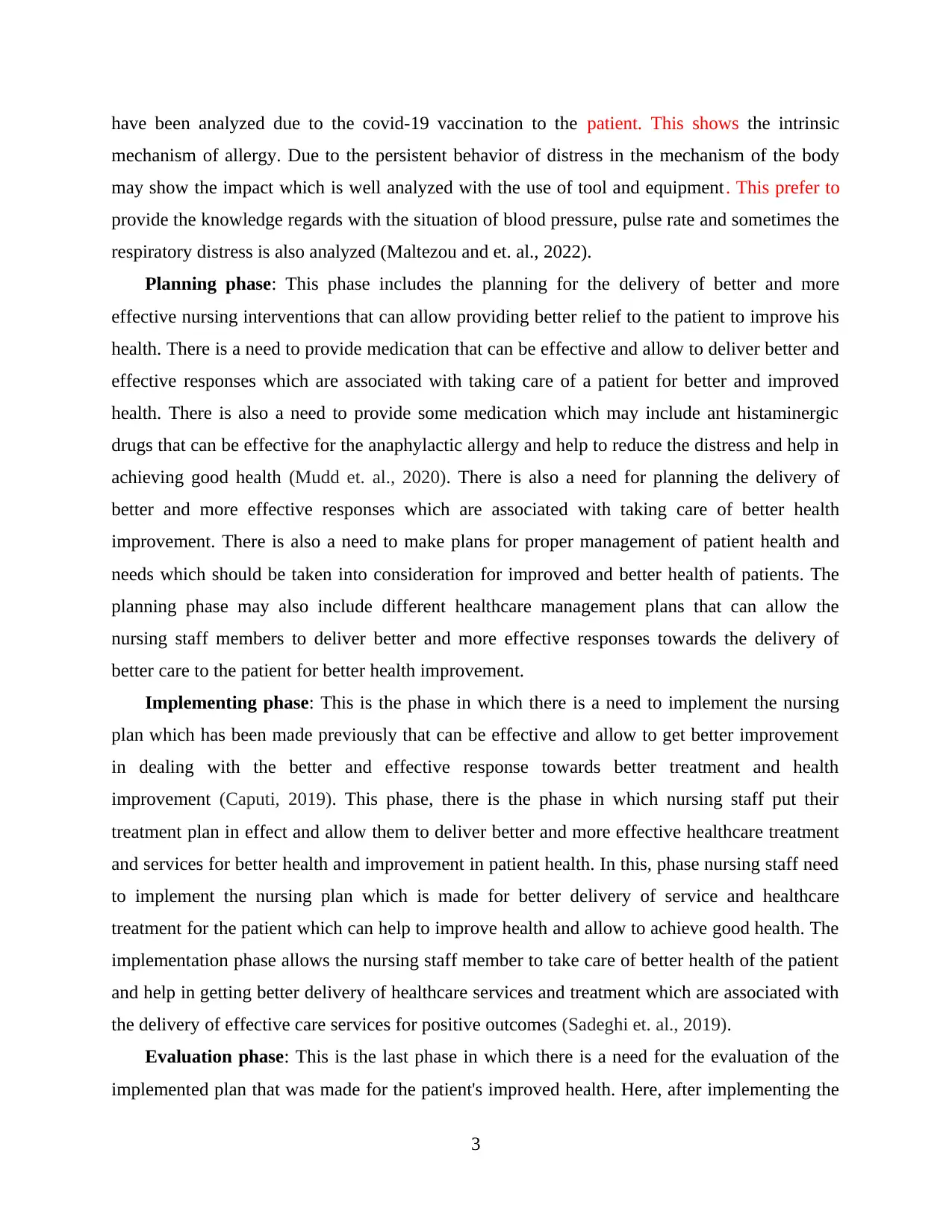
have been analyzed due to the covid-19 vaccination to the patient. This shows the intrinsic
mechanism of allergy. Due to the persistent behavior of distress in the mechanism of the body
may show the impact which is well analyzed with the use of tool and equipment. This prefer to
provide the knowledge regards with the situation of blood pressure, pulse rate and sometimes the
respiratory distress is also analyzed (Maltezou and et. al., 2022).
Planning phase: This phase includes the planning for the delivery of better and more
effective nursing interventions that can allow providing better relief to the patient to improve his
health. There is a need to provide medication that can be effective and allow to deliver better and
effective responses which are associated with taking care of a patient for better and improved
health. There is also a need to provide some medication which may include ant histaminergic
drugs that can be effective for the anaphylactic allergy and help to reduce the distress and help in
achieving good health (Mudd et. al., 2020). There is also a need for planning the delivery of
better and more effective responses which are associated with taking care of better health
improvement. There is also a need to make plans for proper management of patient health and
needs which should be taken into consideration for improved and better health of patients. The
planning phase may also include different healthcare management plans that can allow the
nursing staff members to deliver better and more effective responses towards the delivery of
better care to the patient for better health improvement.
Implementing phase: This is the phase in which there is a need to implement the nursing
plan which has been made previously that can be effective and allow to get better improvement
in dealing with the better and effective response towards better treatment and health
improvement (Caputi, 2019). This phase, there is the phase in which nursing staff put their
treatment plan in effect and allow them to deliver better and more effective healthcare treatment
and services for better health and improvement in patient health. In this, phase nursing staff need
to implement the nursing plan which is made for better delivery of service and healthcare
treatment for the patient which can help to improve health and allow to achieve good health. The
implementation phase allows the nursing staff member to take care of better health of the patient
and help in getting better delivery of healthcare services and treatment which are associated with
the delivery of effective care services for positive outcomes (Sadeghi et. al., 2019).
Evaluation phase: This is the last phase in which there is a need for the evaluation of the
implemented plan that was made for the patient's improved health. Here, after implementing the
3
mechanism of allergy. Due to the persistent behavior of distress in the mechanism of the body
may show the impact which is well analyzed with the use of tool and equipment. This prefer to
provide the knowledge regards with the situation of blood pressure, pulse rate and sometimes the
respiratory distress is also analyzed (Maltezou and et. al., 2022).
Planning phase: This phase includes the planning for the delivery of better and more
effective nursing interventions that can allow providing better relief to the patient to improve his
health. There is a need to provide medication that can be effective and allow to deliver better and
effective responses which are associated with taking care of a patient for better and improved
health. There is also a need to provide some medication which may include ant histaminergic
drugs that can be effective for the anaphylactic allergy and help to reduce the distress and help in
achieving good health (Mudd et. al., 2020). There is also a need for planning the delivery of
better and more effective responses which are associated with taking care of better health
improvement. There is also a need to make plans for proper management of patient health and
needs which should be taken into consideration for improved and better health of patients. The
planning phase may also include different healthcare management plans that can allow the
nursing staff members to deliver better and more effective responses towards the delivery of
better care to the patient for better health improvement.
Implementing phase: This is the phase in which there is a need to implement the nursing
plan which has been made previously that can be effective and allow to get better improvement
in dealing with the better and effective response towards better treatment and health
improvement (Caputi, 2019). This phase, there is the phase in which nursing staff put their
treatment plan in effect and allow them to deliver better and more effective healthcare treatment
and services for better health and improvement in patient health. In this, phase nursing staff need
to implement the nursing plan which is made for better delivery of service and healthcare
treatment for the patient which can help to improve health and allow to achieve good health. The
implementation phase allows the nursing staff member to take care of better health of the patient
and help in getting better delivery of healthcare services and treatment which are associated with
the delivery of effective care services for positive outcomes (Sadeghi et. al., 2019).
Evaluation phase: This is the last phase in which there is a need for the evaluation of the
implemented plan that was made for the patient's improved health. Here, after implementing the
3
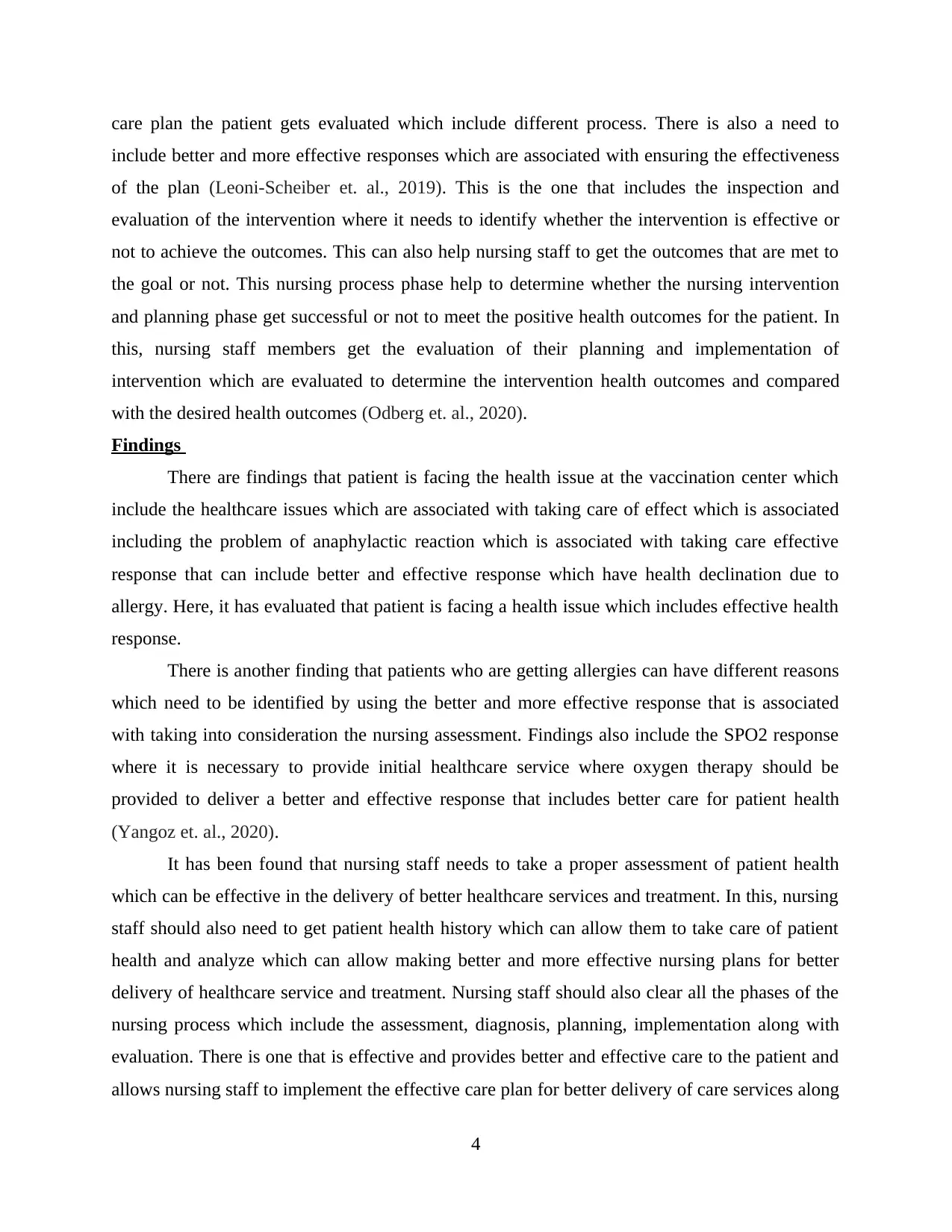
care plan the patient gets evaluated which include different process. There is also a need to
include better and more effective responses which are associated with ensuring the effectiveness
of the plan (Leoni‐Scheiber et. al., 2019). This is the one that includes the inspection and
evaluation of the intervention where it needs to identify whether the intervention is effective or
not to achieve the outcomes. This can also help nursing staff to get the outcomes that are met to
the goal or not. This nursing process phase help to determine whether the nursing intervention
and planning phase get successful or not to meet the positive health outcomes for the patient. In
this, nursing staff members get the evaluation of their planning and implementation of
intervention which are evaluated to determine the intervention health outcomes and compared
with the desired health outcomes (Odberg et. al., 2020).
Findings
There are findings that patient is facing the health issue at the vaccination center which
include the healthcare issues which are associated with taking care of effect which is associated
including the problem of anaphylactic reaction which is associated with taking care effective
response that can include better and effective response which have health declination due to
allergy. Here, it has evaluated that patient is facing a health issue which includes effective health
response.
There is another finding that patients who are getting allergies can have different reasons
which need to be identified by using the better and more effective response that is associated
with taking into consideration the nursing assessment. Findings also include the SPO2 response
where it is necessary to provide initial healthcare service where oxygen therapy should be
provided to deliver a better and effective response that includes better care for patient health
(Yangoz et. al., 2020).
It has been found that nursing staff needs to take a proper assessment of patient health
which can be effective in the delivery of better healthcare services and treatment. In this, nursing
staff should also need to get patient health history which can allow them to take care of patient
health and analyze which can allow making better and more effective nursing plans for better
delivery of healthcare service and treatment. Nursing staff should also clear all the phases of the
nursing process which include the assessment, diagnosis, planning, implementation along with
evaluation. There is one that is effective and provides better and effective care to the patient and
allows nursing staff to implement the effective care plan for better delivery of care services along
4
include better and more effective responses which are associated with ensuring the effectiveness
of the plan (Leoni‐Scheiber et. al., 2019). This is the one that includes the inspection and
evaluation of the intervention where it needs to identify whether the intervention is effective or
not to achieve the outcomes. This can also help nursing staff to get the outcomes that are met to
the goal or not. This nursing process phase help to determine whether the nursing intervention
and planning phase get successful or not to meet the positive health outcomes for the patient. In
this, nursing staff members get the evaluation of their planning and implementation of
intervention which are evaluated to determine the intervention health outcomes and compared
with the desired health outcomes (Odberg et. al., 2020).
Findings
There are findings that patient is facing the health issue at the vaccination center which
include the healthcare issues which are associated with taking care of effect which is associated
including the problem of anaphylactic reaction which is associated with taking care effective
response that can include better and effective response which have health declination due to
allergy. Here, it has evaluated that patient is facing a health issue which includes effective health
response.
There is another finding that patients who are getting allergies can have different reasons
which need to be identified by using the better and more effective response that is associated
with taking into consideration the nursing assessment. Findings also include the SPO2 response
where it is necessary to provide initial healthcare service where oxygen therapy should be
provided to deliver a better and effective response that includes better care for patient health
(Yangoz et. al., 2020).
It has been found that nursing staff needs to take a proper assessment of patient health
which can be effective in the delivery of better healthcare services and treatment. In this, nursing
staff should also need to get patient health history which can allow them to take care of patient
health and analyze which can allow making better and more effective nursing plans for better
delivery of healthcare service and treatment. Nursing staff should also clear all the phases of the
nursing process which include the assessment, diagnosis, planning, implementation along with
evaluation. There is one that is effective and provides better and effective care to the patient and
allows nursing staff to implement the effective care plan for better delivery of care services along
4
⊘ This is a preview!⊘
Do you want full access?
Subscribe today to unlock all pages.

Trusted by 1+ million students worldwide
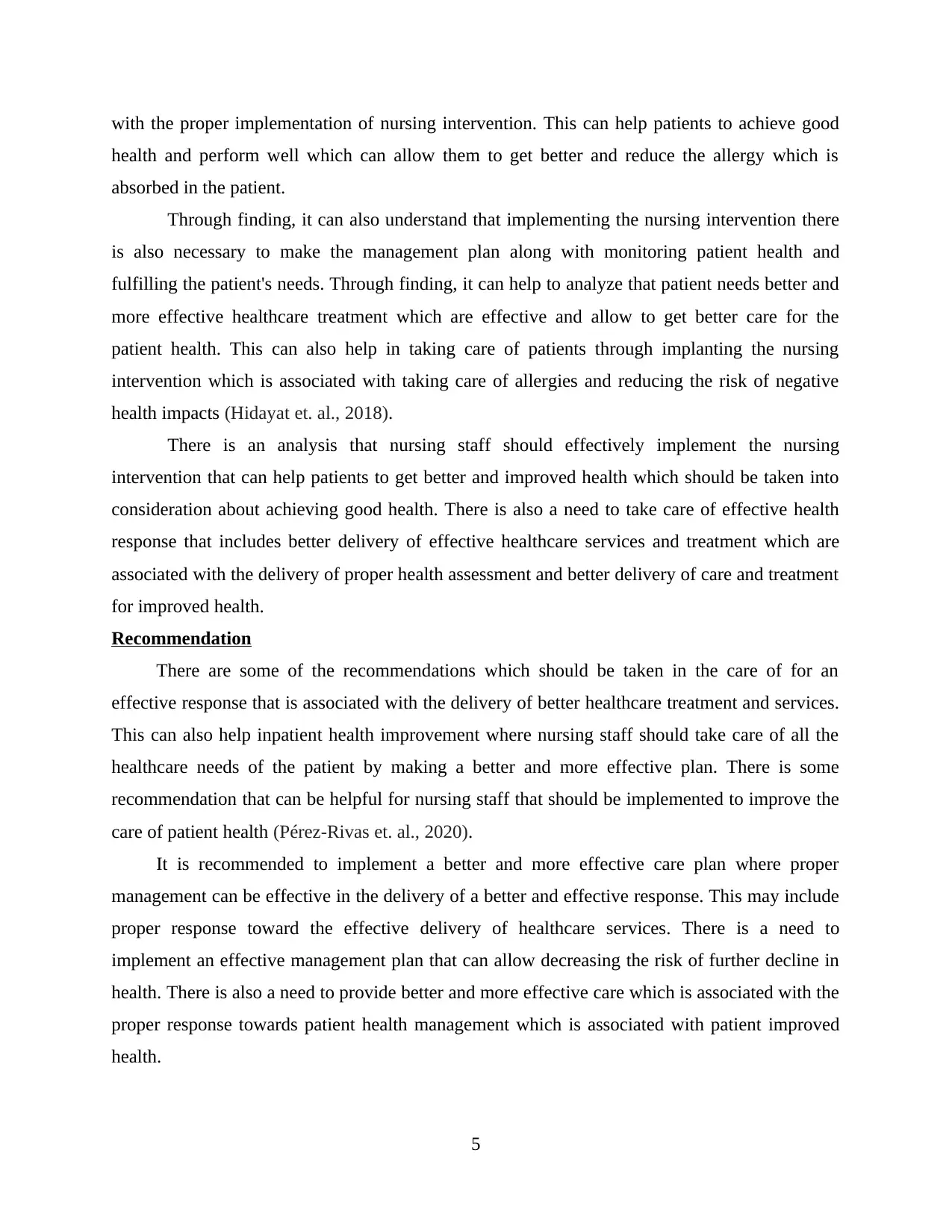
with the proper implementation of nursing intervention. This can help patients to achieve good
health and perform well which can allow them to get better and reduce the allergy which is
absorbed in the patient.
Through finding, it can also understand that implementing the nursing intervention there
is also necessary to make the management plan along with monitoring patient health and
fulfilling the patient's needs. Through finding, it can help to analyze that patient needs better and
more effective healthcare treatment which are effective and allow to get better care for the
patient health. This can also help in taking care of patients through implanting the nursing
intervention which is associated with taking care of allergies and reducing the risk of negative
health impacts (Hidayat et. al., 2018).
There is an analysis that nursing staff should effectively implement the nursing
intervention that can help patients to get better and improved health which should be taken into
consideration about achieving good health. There is also a need to take care of effective health
response that includes better delivery of effective healthcare services and treatment which are
associated with the delivery of proper health assessment and better delivery of care and treatment
for improved health.
Recommendation
There are some of the recommendations which should be taken in the care of for an
effective response that is associated with the delivery of better healthcare treatment and services.
This can also help inpatient health improvement where nursing staff should take care of all the
healthcare needs of the patient by making a better and more effective plan. There is some
recommendation that can be helpful for nursing staff that should be implemented to improve the
care of patient health (Pérez‐Rivas et. al., 2020).
It is recommended to implement a better and more effective care plan where proper
management can be effective in the delivery of a better and effective response. This may include
proper response toward the effective delivery of healthcare services. There is a need to
implement an effective management plan that can allow decreasing the risk of further decline in
health. There is also a need to provide better and more effective care which is associated with the
proper response towards patient health management which is associated with patient improved
health.
5
health and perform well which can allow them to get better and reduce the allergy which is
absorbed in the patient.
Through finding, it can also understand that implementing the nursing intervention there
is also necessary to make the management plan along with monitoring patient health and
fulfilling the patient's needs. Through finding, it can help to analyze that patient needs better and
more effective healthcare treatment which are effective and allow to get better care for the
patient health. This can also help in taking care of patients through implanting the nursing
intervention which is associated with taking care of allergies and reducing the risk of negative
health impacts (Hidayat et. al., 2018).
There is an analysis that nursing staff should effectively implement the nursing
intervention that can help patients to get better and improved health which should be taken into
consideration about achieving good health. There is also a need to take care of effective health
response that includes better delivery of effective healthcare services and treatment which are
associated with the delivery of proper health assessment and better delivery of care and treatment
for improved health.
Recommendation
There are some of the recommendations which should be taken in the care of for an
effective response that is associated with the delivery of better healthcare treatment and services.
This can also help inpatient health improvement where nursing staff should take care of all the
healthcare needs of the patient by making a better and more effective plan. There is some
recommendation that can be helpful for nursing staff that should be implemented to improve the
care of patient health (Pérez‐Rivas et. al., 2020).
It is recommended to implement a better and more effective care plan where proper
management can be effective in the delivery of a better and effective response. This may include
proper response toward the effective delivery of healthcare services. There is a need to
implement an effective management plan that can allow decreasing the risk of further decline in
health. There is also a need to provide better and more effective care which is associated with the
proper response towards patient health management which is associated with patient improved
health.
5
Paraphrase This Document
Need a fresh take? Get an instant paraphrase of this document with our AI Paraphraser
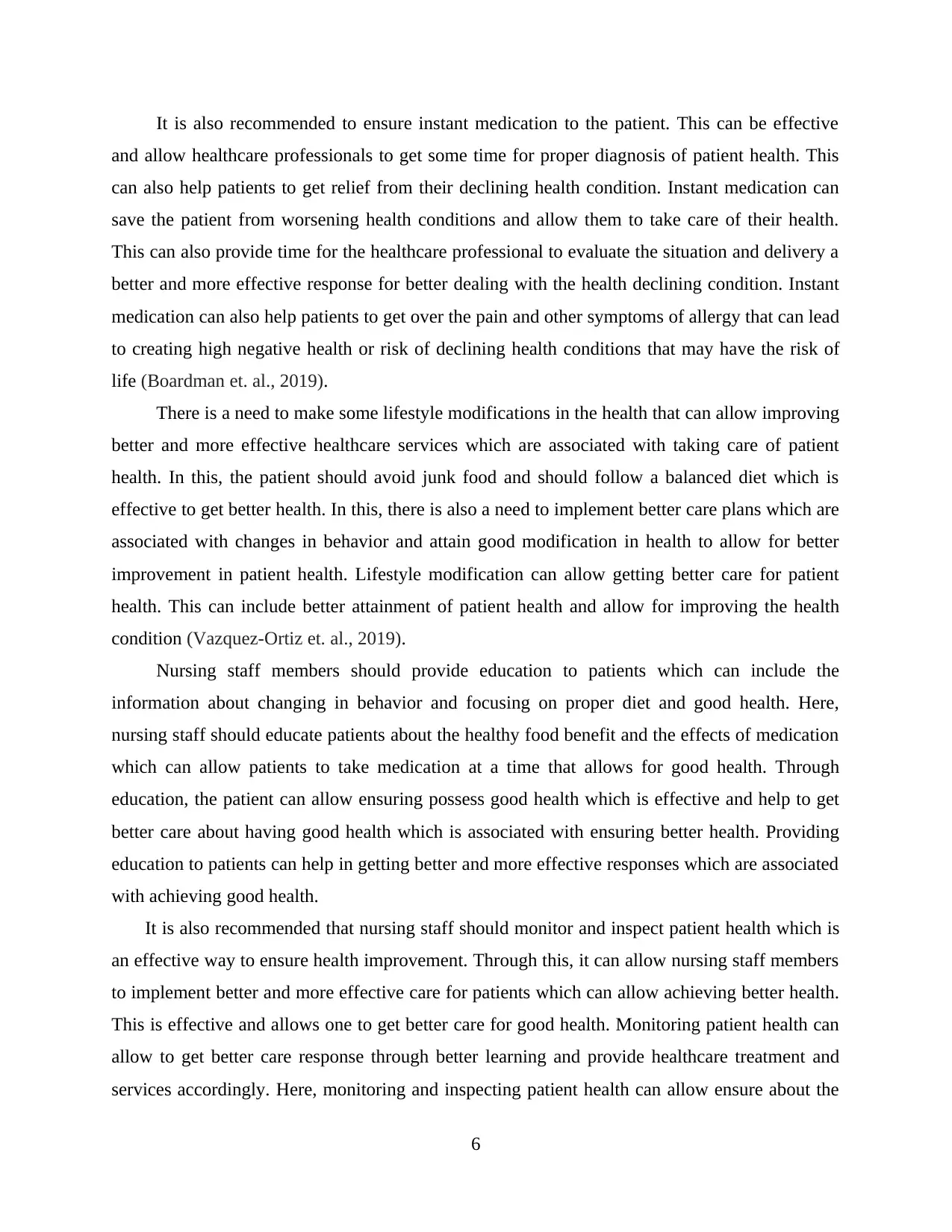
It is also recommended to ensure instant medication to the patient. This can be effective
and allow healthcare professionals to get some time for proper diagnosis of patient health. This
can also help patients to get relief from their declining health condition. Instant medication can
save the patient from worsening health conditions and allow them to take care of their health.
This can also provide time for the healthcare professional to evaluate the situation and delivery a
better and more effective response for better dealing with the health declining condition. Instant
medication can also help patients to get over the pain and other symptoms of allergy that can lead
to creating high negative health or risk of declining health conditions that may have the risk of
life (Boardman et. al., 2019).
There is a need to make some lifestyle modifications in the health that can allow improving
better and more effective healthcare services which are associated with taking care of patient
health. In this, the patient should avoid junk food and should follow a balanced diet which is
effective to get better health. In this, there is also a need to implement better care plans which are
associated with changes in behavior and attain good modification in health to allow for better
improvement in patient health. Lifestyle modification can allow getting better care for patient
health. This can include better attainment of patient health and allow for improving the health
condition (Vazquez-Ortiz et. al., 2019).
Nursing staff members should provide education to patients which can include the
information about changing in behavior and focusing on proper diet and good health. Here,
nursing staff should educate patients about the healthy food benefit and the effects of medication
which can allow patients to take medication at a time that allows for good health. Through
education, the patient can allow ensuring possess good health which is effective and help to get
better care about having good health which is associated with ensuring better health. Providing
education to patients can help in getting better and more effective responses which are associated
with achieving good health.
It is also recommended that nursing staff should monitor and inspect patient health which is
an effective way to ensure health improvement. Through this, it can allow nursing staff members
to implement better and more effective care for patients which can allow achieving better health.
This is effective and allows one to get better care for good health. Monitoring patient health can
allow to get better care response through better learning and provide healthcare treatment and
services accordingly. Here, monitoring and inspecting patient health can allow ensure about the
6
and allow healthcare professionals to get some time for proper diagnosis of patient health. This
can also help patients to get relief from their declining health condition. Instant medication can
save the patient from worsening health conditions and allow them to take care of their health.
This can also provide time for the healthcare professional to evaluate the situation and delivery a
better and more effective response for better dealing with the health declining condition. Instant
medication can also help patients to get over the pain and other symptoms of allergy that can lead
to creating high negative health or risk of declining health conditions that may have the risk of
life (Boardman et. al., 2019).
There is a need to make some lifestyle modifications in the health that can allow improving
better and more effective healthcare services which are associated with taking care of patient
health. In this, the patient should avoid junk food and should follow a balanced diet which is
effective to get better health. In this, there is also a need to implement better care plans which are
associated with changes in behavior and attain good modification in health to allow for better
improvement in patient health. Lifestyle modification can allow getting better care for patient
health. This can include better attainment of patient health and allow for improving the health
condition (Vazquez-Ortiz et. al., 2019).
Nursing staff members should provide education to patients which can include the
information about changing in behavior and focusing on proper diet and good health. Here,
nursing staff should educate patients about the healthy food benefit and the effects of medication
which can allow patients to take medication at a time that allows for good health. Through
education, the patient can allow ensuring possess good health which is effective and help to get
better care about having good health which is associated with ensuring better health. Providing
education to patients can help in getting better and more effective responses which are associated
with achieving good health.
It is also recommended that nursing staff should monitor and inspect patient health which is
an effective way to ensure health improvement. Through this, it can allow nursing staff members
to implement better and more effective care for patients which can allow achieving better health.
This is effective and allows one to get better care for good health. Monitoring patient health can
allow to get better care response through better learning and provide healthcare treatment and
services accordingly. Here, monitoring and inspecting patient health can allow ensure about the
6
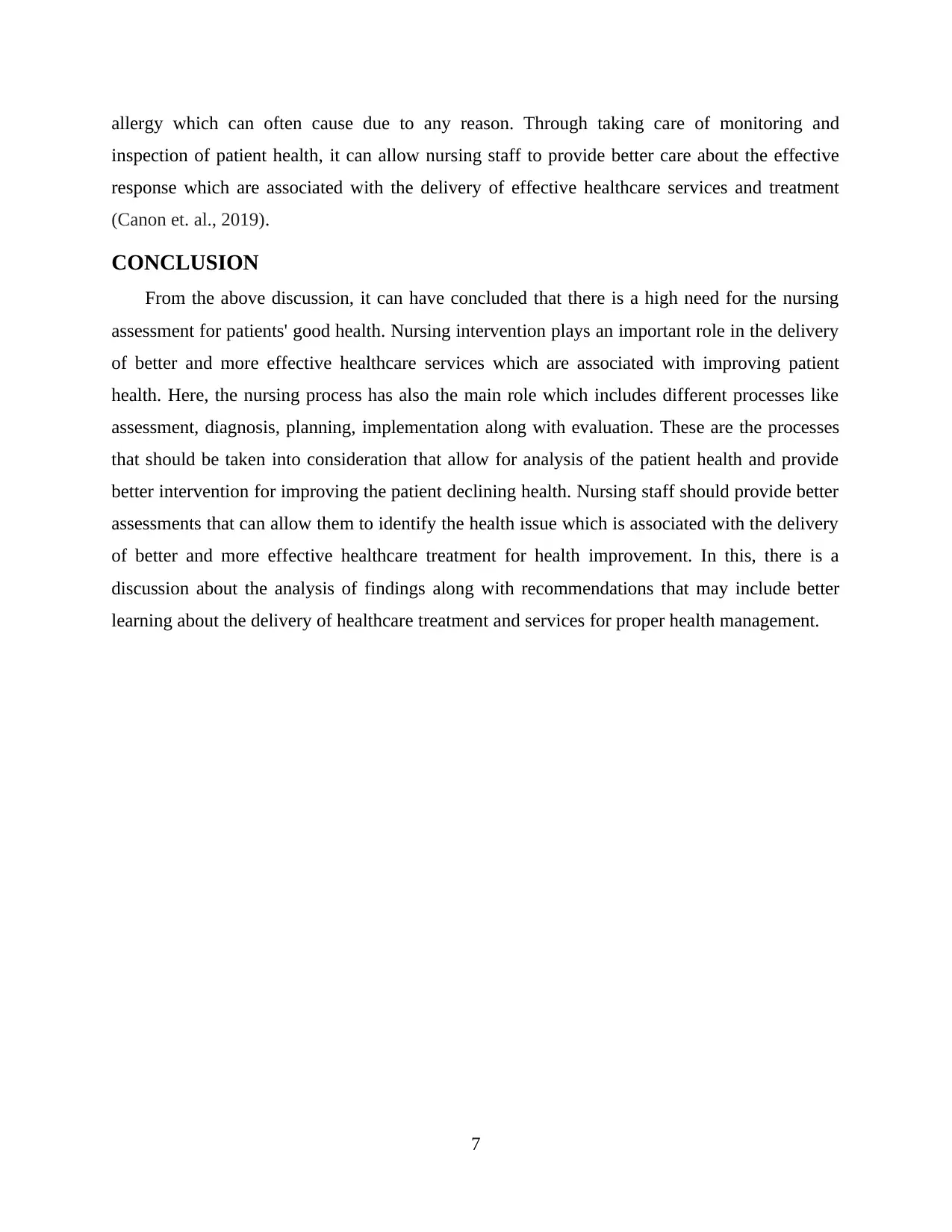
allergy which can often cause due to any reason. Through taking care of monitoring and
inspection of patient health, it can allow nursing staff to provide better care about the effective
response which are associated with the delivery of effective healthcare services and treatment
(Canon et. al., 2019).
CONCLUSION
From the above discussion, it can have concluded that there is a high need for the nursing
assessment for patients' good health. Nursing intervention plays an important role in the delivery
of better and more effective healthcare services which are associated with improving patient
health. Here, the nursing process has also the main role which includes different processes like
assessment, diagnosis, planning, implementation along with evaluation. These are the processes
that should be taken into consideration that allow for analysis of the patient health and provide
better intervention for improving the patient declining health. Nursing staff should provide better
assessments that can allow them to identify the health issue which is associated with the delivery
of better and more effective healthcare treatment for health improvement. In this, there is a
discussion about the analysis of findings along with recommendations that may include better
learning about the delivery of healthcare treatment and services for proper health management.
7
inspection of patient health, it can allow nursing staff to provide better care about the effective
response which are associated with the delivery of effective healthcare services and treatment
(Canon et. al., 2019).
CONCLUSION
From the above discussion, it can have concluded that there is a high need for the nursing
assessment for patients' good health. Nursing intervention plays an important role in the delivery
of better and more effective healthcare services which are associated with improving patient
health. Here, the nursing process has also the main role which includes different processes like
assessment, diagnosis, planning, implementation along with evaluation. These are the processes
that should be taken into consideration that allow for analysis of the patient health and provide
better intervention for improving the patient declining health. Nursing staff should provide better
assessments that can allow them to identify the health issue which is associated with the delivery
of better and more effective healthcare treatment for health improvement. In this, there is a
discussion about the analysis of findings along with recommendations that may include better
learning about the delivery of healthcare treatment and services for proper health management.
7
⊘ This is a preview!⊘
Do you want full access?
Subscribe today to unlock all pages.

Trusted by 1+ million students worldwide
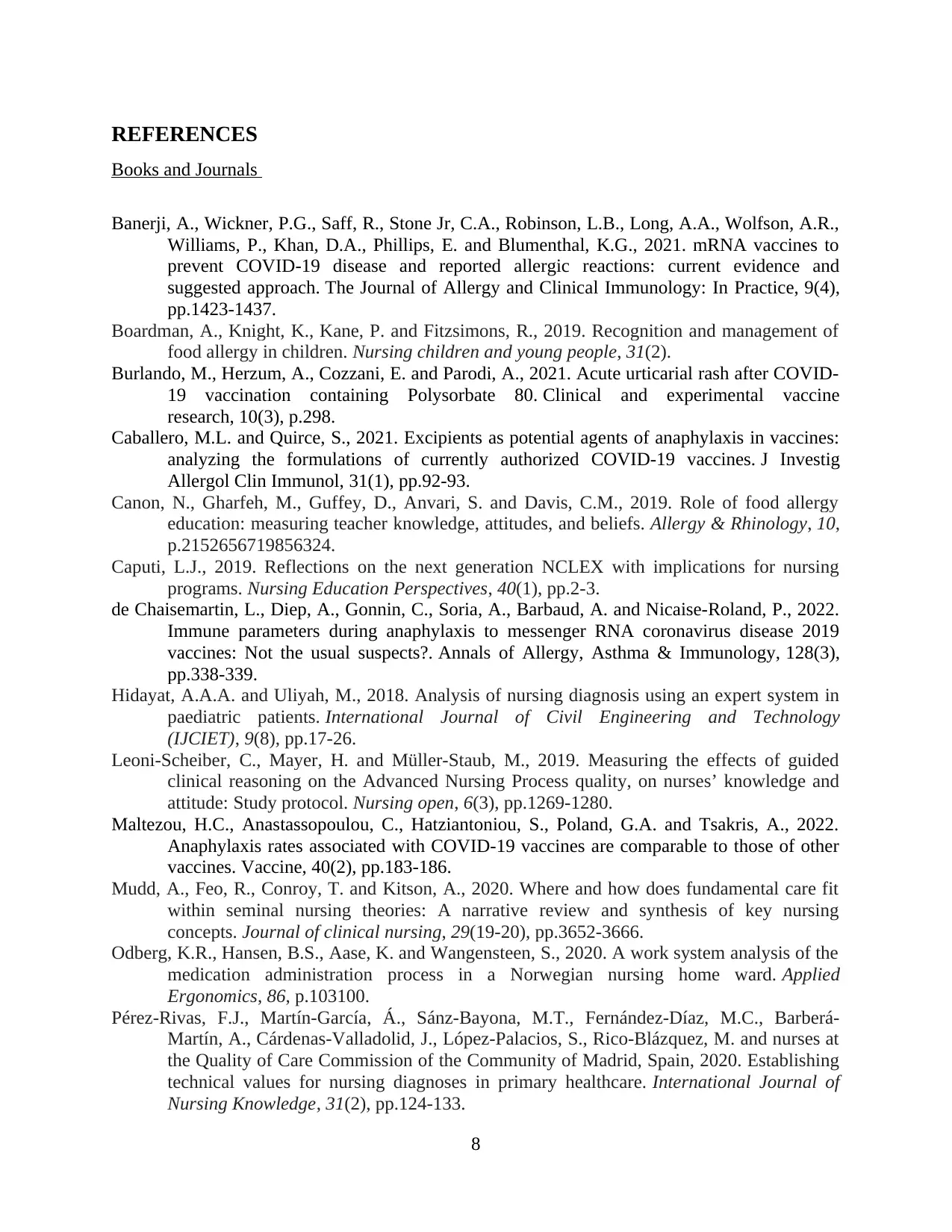
REFERENCES
Books and Journals
Banerji, A., Wickner, P.G., Saff, R., Stone Jr, C.A., Robinson, L.B., Long, A.A., Wolfson, A.R.,
Williams, P., Khan, D.A., Phillips, E. and Blumenthal, K.G., 2021. mRNA vaccines to
prevent COVID-19 disease and reported allergic reactions: current evidence and
suggested approach. The Journal of Allergy and Clinical Immunology: In Practice, 9(4),
pp.1423-1437.
Boardman, A., Knight, K., Kane, P. and Fitzsimons, R., 2019. Recognition and management of
food allergy in children. Nursing children and young people, 31(2).
Burlando, M., Herzum, A., Cozzani, E. and Parodi, A., 2021. Acute urticarial rash after COVID-
19 vaccination containing Polysorbate 80. Clinical and experimental vaccine
research, 10(3), p.298.
Caballero, M.L. and Quirce, S., 2021. Excipients as potential agents of anaphylaxis in vaccines:
analyzing the formulations of currently authorized COVID-19 vaccines. J Investig
Allergol Clin Immunol, 31(1), pp.92-93.
Canon, N., Gharfeh, M., Guffey, D., Anvari, S. and Davis, C.M., 2019. Role of food allergy
education: measuring teacher knowledge, attitudes, and beliefs. Allergy & Rhinology, 10,
p.2152656719856324.
Caputi, L.J., 2019. Reflections on the next generation NCLEX with implications for nursing
programs. Nursing Education Perspectives, 40(1), pp.2-3.
de Chaisemartin, L., Diep, A., Gonnin, C., Soria, A., Barbaud, A. and Nicaise-Roland, P., 2022.
Immune parameters during anaphylaxis to messenger RNA coronavirus disease 2019
vaccines: Not the usual suspects?. Annals of Allergy, Asthma & Immunology, 128(3),
pp.338-339.
Hidayat, A.A.A. and Uliyah, M., 2018. Analysis of nursing diagnosis using an expert system in
paediatric patients. International Journal of Civil Engineering and Technology
(IJCIET), 9(8), pp.17-26.
Leoni‐Scheiber, C., Mayer, H. and Müller‐Staub, M., 2019. Measuring the effects of guided
clinical reasoning on the Advanced Nursing Process quality, on nurses’ knowledge and
attitude: Study protocol. Nursing open, 6(3), pp.1269-1280.
Maltezou, H.C., Anastassopoulou, C., Hatziantoniou, S., Poland, G.A. and Tsakris, A., 2022.
Anaphylaxis rates associated with COVID-19 vaccines are comparable to those of other
vaccines. Vaccine, 40(2), pp.183-186.
Mudd, A., Feo, R., Conroy, T. and Kitson, A., 2020. Where and how does fundamental care fit
within seminal nursing theories: A narrative review and synthesis of key nursing
concepts. Journal of clinical nursing, 29(19-20), pp.3652-3666.
Odberg, K.R., Hansen, B.S., Aase, K. and Wangensteen, S., 2020. A work system analysis of the
medication administration process in a Norwegian nursing home ward. Applied
Ergonomics, 86, p.103100.
Pérez‐Rivas, F.J., Martín‐García, Á., Sánz‐Bayona, M.T., Fernández‐Díaz, M.C., Barberá‐
Martín, A., Cárdenas‐Valladolid, J., López‐Palacios, S., Rico‐Blázquez, M. and nurses at
the Quality of Care Commission of the Community of Madrid, Spain, 2020. Establishing
technical values for nursing diagnoses in primary healthcare. International Journal of
Nursing Knowledge, 31(2), pp.124-133.
8
Books and Journals
Banerji, A., Wickner, P.G., Saff, R., Stone Jr, C.A., Robinson, L.B., Long, A.A., Wolfson, A.R.,
Williams, P., Khan, D.A., Phillips, E. and Blumenthal, K.G., 2021. mRNA vaccines to
prevent COVID-19 disease and reported allergic reactions: current evidence and
suggested approach. The Journal of Allergy and Clinical Immunology: In Practice, 9(4),
pp.1423-1437.
Boardman, A., Knight, K., Kane, P. and Fitzsimons, R., 2019. Recognition and management of
food allergy in children. Nursing children and young people, 31(2).
Burlando, M., Herzum, A., Cozzani, E. and Parodi, A., 2021. Acute urticarial rash after COVID-
19 vaccination containing Polysorbate 80. Clinical and experimental vaccine
research, 10(3), p.298.
Caballero, M.L. and Quirce, S., 2021. Excipients as potential agents of anaphylaxis in vaccines:
analyzing the formulations of currently authorized COVID-19 vaccines. J Investig
Allergol Clin Immunol, 31(1), pp.92-93.
Canon, N., Gharfeh, M., Guffey, D., Anvari, S. and Davis, C.M., 2019. Role of food allergy
education: measuring teacher knowledge, attitudes, and beliefs. Allergy & Rhinology, 10,
p.2152656719856324.
Caputi, L.J., 2019. Reflections on the next generation NCLEX with implications for nursing
programs. Nursing Education Perspectives, 40(1), pp.2-3.
de Chaisemartin, L., Diep, A., Gonnin, C., Soria, A., Barbaud, A. and Nicaise-Roland, P., 2022.
Immune parameters during anaphylaxis to messenger RNA coronavirus disease 2019
vaccines: Not the usual suspects?. Annals of Allergy, Asthma & Immunology, 128(3),
pp.338-339.
Hidayat, A.A.A. and Uliyah, M., 2018. Analysis of nursing diagnosis using an expert system in
paediatric patients. International Journal of Civil Engineering and Technology
(IJCIET), 9(8), pp.17-26.
Leoni‐Scheiber, C., Mayer, H. and Müller‐Staub, M., 2019. Measuring the effects of guided
clinical reasoning on the Advanced Nursing Process quality, on nurses’ knowledge and
attitude: Study protocol. Nursing open, 6(3), pp.1269-1280.
Maltezou, H.C., Anastassopoulou, C., Hatziantoniou, S., Poland, G.A. and Tsakris, A., 2022.
Anaphylaxis rates associated with COVID-19 vaccines are comparable to those of other
vaccines. Vaccine, 40(2), pp.183-186.
Mudd, A., Feo, R., Conroy, T. and Kitson, A., 2020. Where and how does fundamental care fit
within seminal nursing theories: A narrative review and synthesis of key nursing
concepts. Journal of clinical nursing, 29(19-20), pp.3652-3666.
Odberg, K.R., Hansen, B.S., Aase, K. and Wangensteen, S., 2020. A work system analysis of the
medication administration process in a Norwegian nursing home ward. Applied
Ergonomics, 86, p.103100.
Pérez‐Rivas, F.J., Martín‐García, Á., Sánz‐Bayona, M.T., Fernández‐Díaz, M.C., Barberá‐
Martín, A., Cárdenas‐Valladolid, J., López‐Palacios, S., Rico‐Blázquez, M. and nurses at
the Quality of Care Commission of the Community of Madrid, Spain, 2020. Establishing
technical values for nursing diagnoses in primary healthcare. International Journal of
Nursing Knowledge, 31(2), pp.124-133.
8
Paraphrase This Document
Need a fresh take? Get an instant paraphrase of this document with our AI Paraphraser
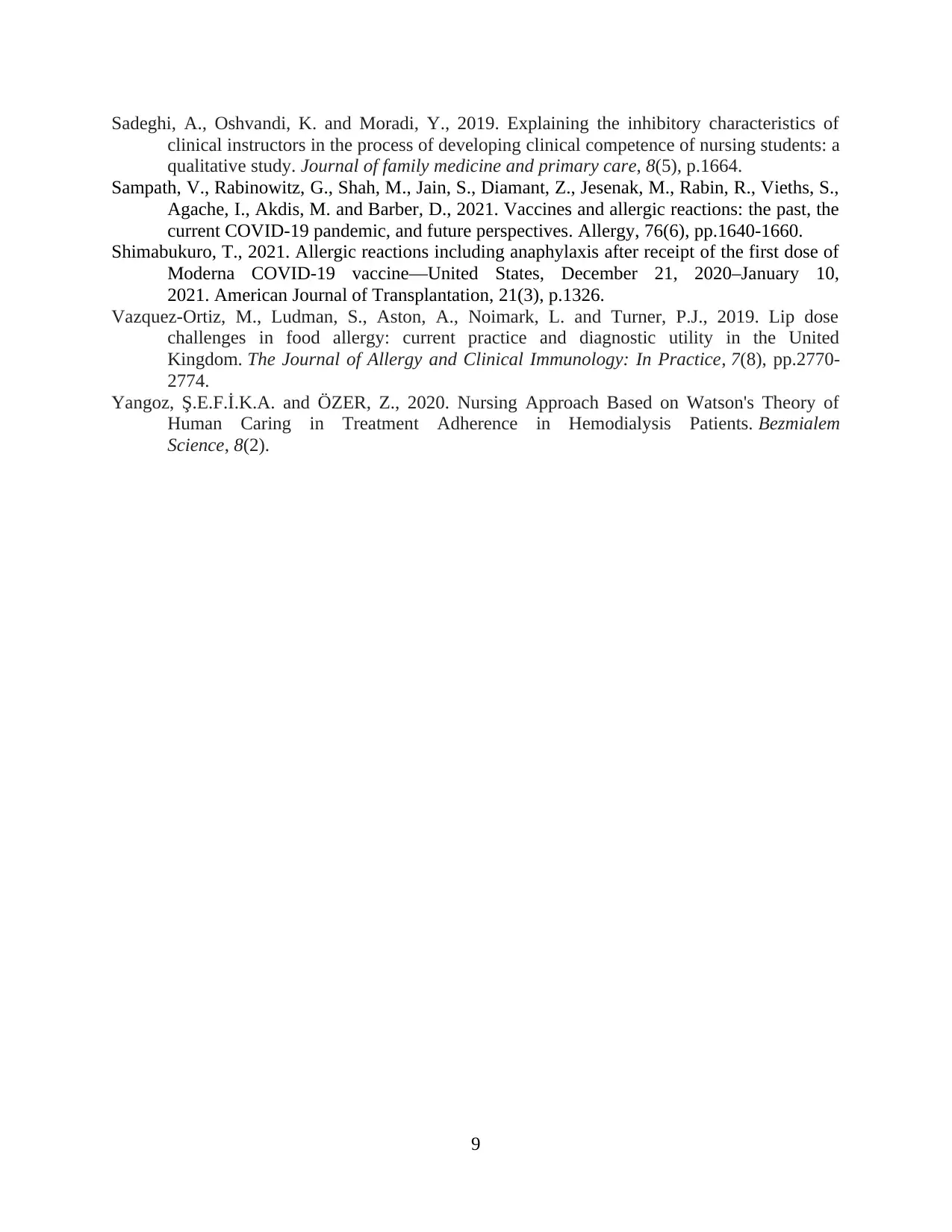
Sadeghi, A., Oshvandi, K. and Moradi, Y., 2019. Explaining the inhibitory characteristics of
clinical instructors in the process of developing clinical competence of nursing students: a
qualitative study. Journal of family medicine and primary care, 8(5), p.1664.
Sampath, V., Rabinowitz, G., Shah, M., Jain, S., Diamant, Z., Jesenak, M., Rabin, R., Vieths, S.,
Agache, I., Akdis, M. and Barber, D., 2021. Vaccines and allergic reactions: the past, the
current COVID‐19 pandemic, and future perspectives. Allergy, 76(6), pp.1640-1660.
Shimabukuro, T., 2021. Allergic reactions including anaphylaxis after receipt of the first dose of
Moderna COVID‐19 vaccine—United States, December 21, 2020–January 10,
2021. American Journal of Transplantation, 21(3), p.1326.
Vazquez-Ortiz, M., Ludman, S., Aston, A., Noimark, L. and Turner, P.J., 2019. Lip dose
challenges in food allergy: current practice and diagnostic utility in the United
Kingdom. The Journal of Allergy and Clinical Immunology: In Practice, 7(8), pp.2770-
2774.
Yangoz, Ş.E.F.İ.K.A. and ÖZER, Z., 2020. Nursing Approach Based on Watson's Theory of
Human Caring in Treatment Adherence in Hemodialysis Patients. Bezmialem
Science, 8(2).
9
clinical instructors in the process of developing clinical competence of nursing students: a
qualitative study. Journal of family medicine and primary care, 8(5), p.1664.
Sampath, V., Rabinowitz, G., Shah, M., Jain, S., Diamant, Z., Jesenak, M., Rabin, R., Vieths, S.,
Agache, I., Akdis, M. and Barber, D., 2021. Vaccines and allergic reactions: the past, the
current COVID‐19 pandemic, and future perspectives. Allergy, 76(6), pp.1640-1660.
Shimabukuro, T., 2021. Allergic reactions including anaphylaxis after receipt of the first dose of
Moderna COVID‐19 vaccine—United States, December 21, 2020–January 10,
2021. American Journal of Transplantation, 21(3), p.1326.
Vazquez-Ortiz, M., Ludman, S., Aston, A., Noimark, L. and Turner, P.J., 2019. Lip dose
challenges in food allergy: current practice and diagnostic utility in the United
Kingdom. The Journal of Allergy and Clinical Immunology: In Practice, 7(8), pp.2770-
2774.
Yangoz, Ş.E.F.İ.K.A. and ÖZER, Z., 2020. Nursing Approach Based on Watson's Theory of
Human Caring in Treatment Adherence in Hemodialysis Patients. Bezmialem
Science, 8(2).
9
1 out of 11
Related Documents
Your All-in-One AI-Powered Toolkit for Academic Success.
+13062052269
info@desklib.com
Available 24*7 on WhatsApp / Email
![[object Object]](/_next/static/media/star-bottom.7253800d.svg)
Unlock your academic potential
Copyright © 2020–2025 A2Z Services. All Rights Reserved. Developed and managed by ZUCOL.





